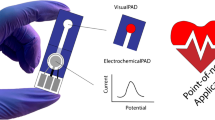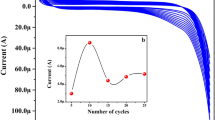Abstract
We report on a novel anti-interference and pH-modulation device (herein after referred to as “device”). It is based on electrodialysis and can continuously increase the pH value of the carrier solution and - at the same time - remove interfering analytical signals obtained for ascorbic acid (AA) and uric acid (UA). The “device” was coupled to the FIA-amperometric detection of glucose. The linear range is from 1 μmol L−1 to 0.4 mmol L−1, with a sensitivity of 213 μA cm−2 mM−1 and a detection limit of 1 μmol L−1 at a signal-to-noise ratio of 3. The method was used to sucessfully determine glucose in serum. This study represents a novel technique for overcoming analytical interference and is expected to find applications in liquid chromatography, for example in on-line pH-modulation if different pH values are needed for separation and detection.

As shown in the figure, a specific electrolytic current was applied between the two electrodes. Thus H2O in the cathode chamber was electrolyzed to produce H2 and OH-. Then the OH- moved through the anion exchange membrane and got into the packed column by electromigration, where it mixed with the carrier solution of Na2SO4. Meanwhile, the SO 2-4 of the carrier solution moved through the other anion exchange membrane and entered the anode chamber. Therefore, the carrier solution of Na2SO4 was partly converted into NaOH after passing through the “device”.





Similar content being viewed by others
References
Wang J (2008) Electrochemical glucose biosensors. Chem Rev 108:814
Su YH, Xie QJ, Chen C, Zhang QF, Ma M, Yao SZ (2008) Electrochemical quartz crystal microbalance studies on enzymatic specific activity and direct electrochemistry of immobilized glucose oxidase in the presence of sodium dodecyl benzene sulfonate and multiwalled carbon nanotubes. Biotechnol Prog 24:262
Park S, Boo H, Chung TD (2006) Electrochemical non-enzymatic glucose sensors. Anal Chim Acta 556:46
Wilson R, Turner APF (1992) Glucose oxidase: an ideal enzyme. Biosens Bioelectron 7:165
Wang GF, Wei Y, Zhang W, Zhang XJ, Fang B, Wang L (2010) Enzyme-free amperometric sensing of glucose using Cu-CuO nanowire composites. Microchim Acta 168:87
Tan CK, Loh KP, John TTL (2008) Direct amperometric detection of glucose on a multiple-branching carbon nanotube forest. Analyst 133:448
Lei H-W, Wu B, Cha C-S, Kita H (1995) Electro-oxidation of glucose on platinum in alkaline solution and selective oxidation in the presence of additives. J Electroanal Chem 382:103
Bai Y, Yang WW, Sun Y, Sun CQ (2008) Enzyme-free glucose sensor based on a three-dimensional gold film electrode. Sens Actuators B 134:471
Tong SF, Jin HY, Zheng DF, Wang W, Li X, Xu YH, Song WB (2009) Investigations on copper-titanate intercalation materials for amperometric sensor. Biosens Bioelectron 24:2404
Ye J-S, Wen Y, Zhang WD, Gan LM, Xu GQ, Sheu F-S (2004) Nonenzymatic glucose detection using multi-walled carbon nanotube electrodes. Electrochem Commun 6:66
Hoshi T, Saiki H, Kuwazawa S, Tsuchiya C, Chen Q, Anzai J-I (2001) Selective permeation of hydrogen peroxide through polyelectrolyte multilayer films and its use for amperometric biosensors. Anal Chem 73:5310
Wu B-Y, Hou S-H, Yin F, Zhao Z-X, Wang Y-Y, Wang X-S, Chen Q (2007) Amperometric glucose biosensor based on multilayer films via layer-by-layer self-assembly of multi-wall carbon nanotubes, gold nanoparticles and glucose oxidase on the Pt electrode. Biosens Bioelectron 22:2854
Matsumoto K, Kamikado H, Matsubara H, Osajima Y (1988) Simultaneous determination of glucose, fructose, and sucrose in mixtures by amperometric flow injection analysis with immobilized enzyme reactors. Anal Chem 60:147
Xu J-J, Luo X-L, Du Y, Chen H-Y (2004) Application of MnO2 nanoparticles as an eliminator of ascorbate interference to amperometric glucose biosensors. Electrochem Commun 6:1169
Su YH, Huang WX, Hu RZ, Ding HD, Hu KK (2009) Development of a novel, sensitive amperometric-FIA glucose biosensor by packing up the amperometric cell with glucose oxidase modified anion exchange resin. Biosens Bioelectron 24:2665
Zhao M, Hibbert DB, Gooding JJ (2003) Solution to the problem of interferences in electrochemical sensors using the fill-and-flow channel biosensor. Anal Chem 75:593
Zurhelle G, Müller-Seitz E, Petz M (2000) Automated residue analysis of tetracyclines and their metabolites in whole egg, egg white, egg yolk and hen’s plasma utilizing a modified ASTED system. J Chromatogr B 739:191
Chen ZL, Hibbert DB (1997) Simultaneous amperometric and potentiometric detection of sugars, polyols and carboxylic acids in flow systems using copper wire electrodes. J Chromatogr A 766:27
Ding HD, Hu RZ, Wu HH, Yao SB (2008) Electroless platinum plating on titanium substrate from an alkaline bath. Chin J Mater Prot 41:29
Johnson DC, LaCourse WR (1990) Liquid chromatography with pulsed electrochemical detection at gold and platinum electrodes. Anal Chem 62:589A
Jensen MB, Johnson DC (1997) Fast wave forms for pulsed electrochemical detection of glucose by incorporation of reductive desorption of oxidation products. Anal Chem 69:1776
Cao YH, Zhang X, Fang YZ, Ye JN (2001) Determination of the active ingredients in Gastrodia rhizoma by capillary electrophoresis with electrochemical detection. Analyst 126:1524
Zhao CZ, Shao CL, Li MH, Jiao K (2007) Flow-injection analysis of glucose without enzyme based on electrocatalytic oxidation of glucose at a nickel electrode. Talanta 71:1769
Nagy L, Nagy G, Hajós P (2001) Copper electrode based amperometric detector cell for sugar and organic acid measurements. Sens Actuators B 76:494
Satheesh Babu TG, Ramachandran T, Nair B (2010) Single step modification of copper electrode for the highly sensitive and selective non-enzymatic determination of glucose. Microchim Acta 169:49
Ueda T, Mitchell R, Kitamura F, Nakamoto A (1992) Constant-potential amperometric detection of carbohydrates at metal electrodes in high-performance anion-exchange chromatography. J Chromatogr A 592:229
Luo MZ, Baldwin RP (1995) Characterization of carbohydrate oxidation at copper electrodes. J Electroanal Chem 387:87
Nagy L, Nagy G (2006) Spectroscopic confirmation of electrocatalytic behavior of amperometric carbohydrate detection on copper electrode. Microchem J 84:70
Small H, Stevens TS, Bauman WC (1975) Novel ion exchange chromatographic method using conductimetric detection. Anal Chem 47:1801
Author information
Authors and Affiliations
Corresponding author
Electronic supplementary material
Below is the link to the electronic supplementary material.
ESM 1
(DOC 68 kb)
Rights and permissions
About this article
Cite this article
Su, Y., Hu, R., Huang, W. et al. A novel anti-interference and pH-modulation device: application to enzyme-free glucose detection. Microchim Acta 173, 19–26 (2011). https://doi.org/10.1007/s00604-010-0501-3
Received:
Accepted:
Published:
Issue Date:
DOI: https://doi.org/10.1007/s00604-010-0501-3




